- April 14, 2022

What are speech marks? Examples and how to use them

From novels to news reports, speech marks are used in all sorts of places! In this guide, we take a look at what they are, where they’re used and some handy rules to keep in mind when using them.
In this blog, jump to:
What are speech marks?
Where are speech marks used, when do children learn about speech marks, how to use speech marks, speech mark examples, how to use speech marks when writing, general rules for using speech marks.
Speech marks are special punctuation marks that show the exact words someone has spoken.
They’re also known as quotation marks and inverted commas, and they always appear in pairs at the beginning and end of what was said.
This is what they look like: “ ”
And here’s an example of some speech marks in action:
“The words that appear between speech marks are the exact words that someone has said,” said the teacher.
You can find speech marks everywhere. They’re common in stories, news articles, poetry and essays. By showing when someone is speaking, speech marks can help make a text more lively and easier to read.
In a story, speech marks may show which of the characters is speaking. For example, in a children’s book you may read:
“We always eat in the garden,” said Markus.
In a news article, speech marks can be used to show a statement made by an expert. For example:
Economists say that “the increase in production will help the job market to grow”.

Children usually start learning about speech marks around the age of 7.
Before they learn about speech marks, they’ll first be taught about other forms of punctuation, including full stops, commas, exclamation marks and question marks.
Being able to tell the difference between direct and indirect speech will help children to effectively use speech marks.
- Direct speech: shows the exact words that were spoken by a person or character. Speech marks are used at the beginning and end of direct speech to represent what someone has said.
- Indirect speech: shows what someone said without using their exact words. Speech marks aren’t used in these cases.
- A reporting clause will let a reader know who said the direct speech and how they said it.
You should always separate direct speech from the reporting clause by a comma.
This may sound a little complicated, but if we look at an example it will all be clearer.
Anne said, “It’s snowing!”
In this example, ‘Anne said’ is the reporting clause, as it lets us know that it was Anne who spoke. This clause is separated by a comma from Anne’s direct speech, which is represented by the text between the speech marks (“It’s snowing!”).
If you’re writing a conversation between multiple people, reporting clauses can also help to clarify who’s speaking, and when.
Let’s take a look at some examples of speech marks in actions. These will help us better understand the different uses of speech marks.
The teacher said that Anthony’s story was “exceptionally written” and that’s why she read it to the whole class.
In this example, a fragmented part of the teacher’s statement is quoted. This is why the statement isn’t capitalised and has no punctuation before or within the quotation marks.
Markus laughed, “Did you see how high I jumped?”
“I know! It was amazing!” Adriana agreed.
In this example, two different people are speaking. The reporting clauses (‘Marcus laughed’ and ‘Adriana agreed’) shows us who is speaking. Each speaker is also placed on a new line to help the reader see that a new person has started speaking.
“It’s amazing,” William exclaimed, “there are bubbles everywhere!”
In this example, the statement made by William is separated by the reporting clause. This is a fun way of adding some character to your writing when using speech marks.
“Polar bears are my favourite real animals,” Mario said. He then told us about the mythical animals he likes more than polar bears.
This is an interesting example because only part of what Mario said is directly written down. The rest is summarised in indirect speech, and this is why there are no speech marks in the second sentence.
If you’d like to quote a phrase or statement, using speech marks will show the reader that these aren’t your original words.
Speech marks are also a great way to give emphasis to certain phrases.
If you’re writing stories, they’ll also help to separate when the different characters are talking. Keep in mind that speech is a faster way of moving a story forward, so be careful about how much you use them!
There are a few helpful rules to keep in mind when using speech marks:
- Sentences made by different characters or people will need to be in separate lines
- If you’re using a person’s full statement, the punctuation of the sentence will need to be within the quotation marks. This includes full stops, exclamation marks, and question marks.
- If a reporting clause is before the speech marks, you’ll need a comma to separate the two. This comma will be before the speech marks.
- If a reporting clause comes in the middle of two quoted sentence parts, you’ll need a comma at the end of the speech marks in the first part and at the beginning of the speech marks in the second part of the sentence
Final thoughts
Using speech marks is relatively easy once you realise that they’re only used to express what someone said. When writing an essay or story, speech marks can also help to make your writing more interesting and even livelier!
To learn even more about speech marks, why not download the DoodleEnglish app ?
It’s filled with interactive exercises exploring the topic, making it the perfect way to put your learning into practice.
Best of all, it’s designed to be used for just 10 minutes a day — and you can try it for absolutely free!
Related posts
What we offer
Quick links
All rights reserved.

Are you a parent, teacher or student?
Get started for free!
Maths information pack
We ask for your contact info so we can send our info pack directly to your inbox for your convenience, exam prep information pack, case studies information pack.
Book a chat with our team

I’m new to Doodle

My school is already using Doodle

Information pack
We ask for your contact info so that our education consultants can get in touch with you and let you know a bit more about doodle., student login, which programme would you like to use.
DoodleMaths
DoodleTables
DoodleEnglish
DoodleSpell
If you’d like to use Doodle’s browser version, please visit this page on a desktop.
To log in to Doodle on this device, you can do so through our apps. You can find out how to download them here:

When do you use quotation marks (‘ ’) or (“ ”) in English? - Easy Learning Grammar
Direct speech.
- to draw attention to a word
- to indicate an unusual use of a word
- to suggest that the writer want to be distanced from a word.
Quick word challenge
Quiz Review
Score: 0 / 5

Have a language expert improve your writing
Run a free plagiarism check in 10 minutes, generate accurate citations for free.
- Knowledge Base
- Language rules
- When to Use Quotation Marks (“”) | Rules & Examples
When to Use Quotation Marks ("") | Rules & Examples
Published on May 21, 2019 by Shona McCombes . Revised on November 29, 2022 by Jack Caulfield.
Quotation marks (also known as quotes or inverted commas) are used to indicate direct speech and quotations.
In academic writing, you need to use quotation marks when you quote a source . This includes quotes from published works and primary data such as interviews . The exception is when you use a block quote, which should be set off and indented without quotation marks.
Whenever you quote someone else’s words, use a signal phrase to introduce it and integrate the source into your own text. Don’t rely on quotations to make your point for you.
Instantly correct all language mistakes in your text
Upload your document to correct all your mistakes in minutes

Table of contents
Single vs. double quotation marks, quotes within quotes, punctuation following quotations, quotation marks for source titles, indirect quotation, scare quotes, frequently asked questions about quotation marks.
There are two types of quotation marks: ‘single’ and “double.” Which one to choose generally depends on whether you are using US or UK English . The US convention is to use double quotation marks, while the UK convention is usually to use single quotation marks.
Double quotation marks can also be acceptable in UK English, provided you are consistent throughout the text. APA Style requires double quotations.
Here's why students love Scribbr's proofreading services
Discover proofreading & editing
When your quotations are nested (i.e., a quote appears inside another quote), you should use the opposite style of quotation marks for the nested quotation.
US and UK English also differ on where to place punctuation within quotation marks.
- In US English, commas and periods that follow a quote are placed within the quotation marks.
- In UK English, all punctuation marks are placed outside the quotation marks, except when they are part of the original quotation.
In all variants of English, a question mark appears inside the quotation marks when the person quoted was asking a question, but outside when it’s you asking the question.
- Smith asks, “How long can this situation continue?”
- How many participants reported their satisfaction as “high”?
Note that when you include a parenthetical citation after a quote, the punctuation mark always comes after the citation (except with block quotes ).
- Solis described the situation as “precarious” (2022, p. 16).
Some source titles (e.g., the title of a journal article) should be presented in quotation marks in your text. Others are italicized instead (or occasionally written in plain text).
The rules for how to format different source titles are largely the same across citation styles, though some details differ. The key principles apply in all the main styles:
- Use italics for sources that stand alone
- Use quotation marks for sources that are part of another source
Some examples are shown below, with the proper formatting:
- The Routledge Companion to Critical Theory [book]
- “Poststructuralism” [book chapter]
- Philosophy, Psychiatry & Psychology [journal]
- “What Is Personality Disorder?” [journal article]
- Friends [TV series]
- “The One Where Rachel Quits” [TV episode]
Check for common mistakes
Use the best grammar checker available to check for common mistakes in your text.
Fix mistakes for free
Indirect quotation means reporting what someone said without using exactly the same words they did.
It’s a lot like paraphrasing , except that you’re only changing the words you need to in order to fit the statement into your new sentence grammatically. For example, changing the pronouns or the verb tense .
Indirect quotation is more common in everyday speech, but it can occur in academic writing too. When it does, keep in mind that you should only use quotation marks around words taken directly from the original speaker or author.
- One participant stated that “he found the exercises frustrating.”
- One participant stated that he found the exercises frustrating.
- One participant described the exercises as “frustrating.”
“Scare quotes” are quotation marks used around words that are not a direct quotation from a specific source. They are used to signal that a term is being used in an unusual or ironic way, that it is borrowed from someone else, or that the writer is skeptical about the term.
- Many politicians have blamed recent electoral trends on the rise of “fake news.”
While scare quotes have their uses in academic writing (e.g., when referring to controversial terms), they should only be used with good reason. Inappropriate use of scare quotes creates ambiguity.
- The institution organized a fundraiser in support of “underprivileged children.”
- Scientists argue that “global warming” is accelerating due to greenhouse gas emissions.
- The “Brexit” negotiations are still ongoing.
In these examples, the words within scare quotes are widely accepted terms with clear meanings that can’t be attributed to a specific person or source. Using quotation marks implies skepticism about the concepts in question.
The use of single and double quotation marks when quoting differs between US and UK English . In US English, you must use double quotation marks. Single quotation marks are used for quotes within quotes.
In UK English, it’s most common to use single quotation marks, with double quotation marks for quotes within quotes, although the other way around is acceptable too.
A quote is an exact copy of someone else’s words, usually enclosed in quotation marks and credited to the original author or speaker.
If you’re quoting from a text that paraphrases or summarizes other sources and cites them in parentheses , APA and Chicago both recommend retaining the citations as part of the quote. However, MLA recommends omitting citations within a quote:
- APA: Smith states that “the literature on this topic (Jones, 2015; Sill, 2019; Paulson, 2020) shows no clear consensus” (Smith, 2019, p. 4).
- MLA: Smith states that “the literature on this topic shows no clear consensus” (Smith, 2019, p. 4).
Footnote or endnote numbers that appear within quoted text should be omitted in all styles.
If you want to cite an indirect source (one you’ve only seen quoted in another source), either locate the original source or use the phrase “as cited in” in your citation.
Quotes within quotes are punctuated differently to distinguish them from the surrounding quote .
- If you use double quotation marks for quotes, use single quotation marks for quotes within quotes.
- If you use single quotation marks for quotes (e.g., in UK English ), use double quotation marks for quotes within quotes.
Make sure to close both sets of quotes!
Indirect quotation means reporting what someone said (or wrote) but not using their exact words. It’s similar to paraphrasing , but it only involves changing enough words to fit the statement into your sentence grammatically (e.g., changing the tense or the pronouns ).
Since some of the words have changed, indirect quotations are not enclosed in quotation marks .
Sources in this article
We strongly encourage students to use sources in their work. You can cite our article (APA Style) or take a deep dive into the articles below.
McCombes, S. (2022, November 29). When to Use Quotation Marks ("") | Rules & Examples. Scribbr. Retrieved April 15, 2024, from https://www.scribbr.com/language-rules/quotation-marks/
Butterfield, J. (Ed.). (2015). Fowler’s dictionary of modern English usage (4th ed.). Oxford University Press.
Garner, B. A. (2016). Garner’s modern English usage (4th ed.). Oxford University Press.
Is this article helpful?
Shona McCombes
Other students also liked, how to quote | citing quotes in apa, mla & chicago, how to block quote | length, format and examples, what is your plagiarism score.
Style Manual
Secondary navigation, quotation marks.
Quotation marks draw attention to words and reference certain kinds of titles. Write most direct speech in single quote marks. For long quotes, use block quotes without quotation marks.
Quote direct speech in single quote marks
Single quotation marks are also known as ‘quote marks’, ‘quotes’, ‘speech marks’ or ‘inverted commas’.
Use them to:
- show direct speech and the quoted work of other writers
- enclose the title of certain works
- draw attention to a word you’re defining.
Double quotation marks aren’t Australian Government style. Use them only for quotations within quotations.
Short quotations of direct speech are enclosed in single quotation marks.
- ‘ Yes, that’s all that happened, ’ she replied.
- The opposition leader asked, ‘ But where’s the money going to come from? ’
Don’t use quotation marks for long quotations. Instead, use block quotes.
Quotes within quotes
For quotations within quotations, use double quotation marks inside single ones.
He also wrote, ‘ The decisions of the department for “ major procurement ” were always political choices. ’
Omissions in direct speech
When quoting direct speech, take great care to be accurate. Writers and publishers have been sued for inaccurate quotations attributed as direct speech.
If you use ellipses for omitted words, ensure that the omission won’t mislead readers about the content or tone of the source you’re quoting.
- He said, ‘ I don’t agree with the proposal because we need to do more research. ’
- He said, ‘ I don’t agree with the proposal … ’
- He said, ‘ I don’t agree with the proposal. ’
- He said, ‘ I … agree with the proposal. ’
If the quotation needs the information for context, add specific detail in square brackets . You must be sure that the specific detail is correct and that it retains the meaning intended by the original speaker.
‘ The [ Queensland ] government agrees. ’
If you paraphrase omitted material, place the paraphrasing in square brackets.
‘ They all listened to [ the new manager’s ] speech. ’
Errors in quoted material
Quoted material sometimes contains a spelling or grammatical error.
To show the error is in the original, insert an italicised ‘ sic ’ in non-italicised square brackets after the error. This shows the reader that the error comes from the original.
The email read, ‘ At the time, the population of Sydney was much higher than Melberne [ sic ] . ’
Non-Australian English quotes
In quoted material use the original spelling of the quoted material, even if it uses US spellings such as ‘color’. The capitalisation of words must also be the same as in the original.
If the US material uses the US conventions for quotation marks, you can update them to the Australian convention.
Australian style
The President said, ‘ The Prime Minister told me “ No ” , so I’m working on an updated plan. ’
The President said, “ The Prime Minister told me ‘ No, ’ so I’m working on an updated plan. ”
Format long quotes as block quotes with no quotation marks
Quotations that are longer than about 30 words are:
- usually indented from the text margin
- sometimes set in a smaller font size or a different font.
When they are set like this, they are called ‘block quotations’.
Don’t use quotation marks to identify the quoted material – the formatting does that instead. Block quotes should also be coded with the HTML <blockquote> element.
As Templeton (2019) writes:
According to the ACT Auditor-General, the transport benefits from the project are projected to be lower than the costs. She noted other benefits that had been included by the ACT Government to justify the project.
To include several paragraphs of quoted speech without the attribution tag, such as in a media release, use a quotation mark:
- at the beginning of each paragraph
- at the end of the last paragraph only.
- Dr Nicoll said, ‘ My experience as a public servant helped me learn how to run workshops.
- ‘ My experience also helps me make my workshops practical. ’
Write speech in transcripts and plays with no quotation marks
Quotation marks are unnecessary in transcripts and plays if the name of the speaker comes before the direct speech.
- Senator MARCELLUS: Look at the latest report. These results aren’t great.
- Dr BERNARDO: I’ve seen this happen before. It looks like we might be over budget.
The same applies for questions and answers (Q&As).
Q. Have you ever been convicted of an offence, other than a parking or speeding offence?
Refer to certain kinds of titles using quotation marks
When referring to these titles, use quotation marks in references and citations :
- a chapter in a book or report
- an article in a periodical
Read the chapter titled ‘ Number and natural language ’ in The innate mind: structure and contents. It describes how people learn to recognise numbers.
Draw attention to words using quotation marks
You can use quotation marks instead of italics to make words stand out from your sentence. Examples include:
- a technical term on its first mention in a non-technical document
- a word or phrase that has been coined or that you’re using in a specific sense
- colloquial words, nicknames, slang, or ironic or humorous words and phrases, in formal writing.
You don’t usually need to repeat the quotation marks the next time you use the word. They might be useful if the next mention is a long way from the first.
Another use of quotation marks is for words introduced by expressions such as ‘titled’, ‘marked’, ‘the term’ and ‘defined as’.
- The papers were marked ‘ Five Eyes only ’ .
- Can anyone here define ‘ entropion ’ ?
- The survey used the term ‘ companion animal ’ to describe assistance dogs in workplaces.
- He said the new policy was ‘ obviously a great success ’ and then explained its many failings.
Keep quoted punctuation marks in the quote
Punctuation in and after quotation marks depends on the punctuation of the quoted text and how it is used in the content.
If the punctuation mark is part of the quoted text, place the punctuation mark before the closing quotation mark.
- ‘ Is it okay to ask a colleague out for a coffee? ’ I asked the HR section.
- He asked, ‘ Has it arrived? ’
The same rule applies for directly quoted speech followed by the attribution.
- ‘ It has arrived, ’ said the manager.
- ‘ Has it arrived? ’ asked the manager.
If the punctuation mark is part of the sentence outside the quoted text, it follows the closing quotation mark.
- She said that it was ‘ time to start work ’ .
- Many things have been called ‘ the new black ’ , but they usually fade to grey.
- Did the complainant at any time ask you to ‘ Please turn down the noise ’ ?
Quoted material can appear as parenthetical information, enclosed in parentheses, dashes or commas . In these cases, place the quotation marks inside the sentence punctuation.
- His stirring speech ( ‘ We shall never surrender ’ ) galvanised the UK and its allies.
- His stirring speech – ‘ We shall never surrender ’ – galvanised the UK and its allies.
- His stirring speech, ‘ We shall never surrender ’ , galvanised the UK and its allies.
If the quotation ends a sentence or is a sentence in its own right, place the final full stop before the final quotation mark.
- She said, ‘ It’s time to start work .’
- ‘ When we get the final figures,’ the manager said, ‘ we’ll know how it will affect our bottom line .’
- ‘ I have the final figures,’ the manager said. ‘ This will ruin our bottom line .’
Sometimes, there are 2 punctuation marks – one for the quotation and one for the sentence. Decide which is stronger and use it. Don’t use both punctuation marks.
- The Speaker called ‘Order ! ’
- Did you hear him say, ‘That’s unlikely’ ?
- The Speaker called ‘Order ! ’ .
- Did you hear him say, ‘That’s unlikely . ’ ?
The surrounding text determines the font (roman, italic, or bold) of the quotation marks. If the content inside the quotation marks is in italics, but the sentence is in roman, use roman for the quotation marks.
- She described it as ‘ weird ’ . [The quotation marks are in roman even though ‘weird’ is in italics.]
- ‘ Wow, ’ he said. [Both the quote marks and the quote are in roman type.]
Release notes
The digital edition revises advice about punctuation used with quotation marks. It departs from advice in the sixth edition about the position of punctuation and quotation marks in sentences interrupted by expressions, such as ‘they said’.
The sixth edition recommended the comma be placed outside the quotation mark, before the expression . The digital edition recommends the comma be placed inside the quotation mark: the quotation mark comes directly before the expression .
The Content Guide had advice on the use of single and double quotation marks, with which the digital edition is consistent.
About this page
Oxford University Press (2016) ‘9.2 Layout of quoted text’, New Oxford style manual , Oxford University Press, Oxford.
University of Chicago (2017) ‘6.40 Commas with quotations’, Chicago manual of style, 17th edn, University of Chicago Press, Chicago.
Dixon JC and Bolitho B (2005–2019) Course notes and exercises: editing and proofreading for the workplace , Centre for Continuing Education, Australian National University, Canberra.
Houston K (2015) The long and fascinating history of quotation marks ’, Slate , accessed 20 February 2020 .
Microsoft Corporation (2019) Keyboard shortcuts in Word: insert international characters , Microsoft website, accessed 1 December 2019.
Mozilla (n.d.) ‘< blockquote>: The Block Quotation element ’, HTML elements , MDN Web Docs website, accessed 3 December 2020.
Murphy EM and Cadman H (2014) Effective writing: plain English at work , 2nd edn, Lacuna, 2014.
Owen M (2018) How to type accented letters in macOS three different ways , appleinsider website, accessed 4 December 2019.
Oxford University Press (2016) ‘Quotations and direct speech’, New Oxford style manual , Oxford University Press, Oxford.
Seely J (2001) Oxford everyday grammar , Oxford University Press, Oxford.
Stilman S (2004) Grammatically correct , Writer’s Digest Books, Ohio.
Truss L (2003) Eats, shoots and leaves: the zero tolerance approach to punctuation , Profile Books, London, 2003.
The Unicode Consortium (2019) Unicode , Unicode website, accessed 2 December 2019.
University of Chicago (2017) ‘6.115: “Smart” quotation marks’, Chicago manual of style, 17th edn, University of Chicago Press, Chicago.
World Wide Web Consortium (W3C (n.d.) ‘ HTML <blockquote> tag ’, W3CSchools website, accessed 3 December 2020.
Whitbread D (2009) Design manual, 2nd edn, UNSW Press, Sydney, Australia.
Last updated
This page was updated Monday 24 October 2022.
Help us improve the Style Manual

Grammar: How To Use Speech Marks Correctly
Written by Dan
Last updated September 20, 2023
Understanding how to use speech marks correctly in reading and writing is an essential grammar skill that can help your students effectively communicate their ideas.
However, mastering the correct usage of these punctuation symbols can be a challenge for some children.
By clearly demonstrating the purpose of speech marks and providing plenty of practice opportunities, you can give your students the confidence to utilize them accurately in all sorts of contexts.
In this blog post, we will discuss what speech marks are, when they should be used, and how to teach effective grammar lessons focusing on their use.
So, if you’re looking for fresh ways to engage students with learning about grammar via speech mark practices then keep reading!

Table of Contents
Understanding Speech Marks
What are speech marks.
Speech marks, also known as quotation marks or inverted commas, are punctuation marks used in pairs to indicate direct speech, a quotation, or a phrase.
They play a key role in guiding the reader through the text by indicating who is speaking or highlighting essential phrases.
Have you ever wondered how you know when a character in a book is speaking? That’s right! It’s because of the speech marks.
The Role and Importance of Speech Marks in Writing and Reading
Speech marks serve a critical function in both writing and reading. In writing, they help to distinguish dialogue from narrative, highlight specific phrases or words for emphasis, and indicate direct quotations from sources.
In reading, they provide visual cues that aid comprehension and interpretation.
Imagine reading a novel without speech marks. It would be challenging to differentiate between the characters’ spoken words and the author’s narrative, wouldn’t it?
Speech marks create clarity and structure, making our reading experience more enjoyable and efficient.
Common Misconceptions About Speech Marks
One common misconception is that speech marks are only used to denote dialogue. While this is one of their primary functions, it is not their sole purpose.
They can also be used to indicate irony, introduce unfamiliar terms or phrases, or signify titles of short works.
Another misconception is that single and double speech marks can be used interchangeably. However, their usage varies based on regional style guidelines.
For instance, American English typically uses double speech marks (” “), while British English often prefers single speech marks (‘ ‘).
When to Use Speech Marks
Scenarios for using speech marks.
Speech marks are not just decorative flourishes in our writing; they have specific functions and should be used appropriately. So, when exactly should we use them?
- Direct Speech : This is the most common scenario for using speech marks. Whenever a character or person is speaking directly, their words should be enclosed within speech marks. For instance: “I’m excited about the upcoming vacation,” she said.
- Quotations : When quoting a phrase or sentence directly from a source, we use speech marks to indicate that these are not our own words. For example: As Albert Einstein once said, “Imagination is more important than knowledge.”
- Titles of Short Works : Speech marks are used to denote the titles of short works like poems , short stories, song titles, and articles. Example: I just read “The Road Not Taken” by Robert Frost.
- Words Used Unusually or Sarcasm : When a word is used in an unconventional way or to indicate sarcasm or irony, it is often placed within speech marks. Example: He was so “excited” to clean his room.

Examples Demonstrating Correct Use of Speech Marks
Let’s put this into practice with some examples:
- Direct Speech: John said, “I will pick you up at 8 pm.”
- Quotation: The motivational speaker started his speech with, “As Nelson Mandela once said, ‘It always seems impossible until it’s done.'”
- Title: Have you read the “Rime of the Ancient Mariner”?
- Sarcasm: Yeah, I really “love” getting stuck in traffic.
Common Mistakes and How to Avoid Them
Even with the best intentions, errors can creep into our use of speech marks. Here are some common mistakes and how to avoid them:
- Incorrect Placement of Punctuation : In American English, periods and commas go inside the speech marks, regardless of logic. For instance: “I’m going to the park,” she said. Not “I’m going to the park”, she said.
- Single and Double Speech Marks : Remember, the use of single (‘ ‘) and double (” “) speech marks depends on regional style guidelines. Stick to one style consistently throughout your writing.
- Unnecessary Use of Speech Marks : Speech marks should not be used for emphasis. Instead, use italics or bold. Incorrect: The “best” ice cream in town. Correct: The best ice cream in town.
How to Teach Speech Marks Effectively
The importance of clear demonstrations and practice opportunities.
Teaching speech marks is not just about explaining the rules; it’s about illustrating these rules with clear examples and providing ample practice opportunities.
Why, you ask? Because learning is a process of doing. It’s one thing to understand the theory behind speech marks, but applying that knowledge consistently in writing is what truly ingrains the concept.
To demonstrate the use of speech marks, start by showing students examples from their favorite books or articles. Discuss how the speech marks guide them through who’s speaking or what’s being emphasized.
Then, let them practice by writing dialogues or quoting phrases, and encourage peer reviews for constructive feedback.
Strategies and Tips for Teaching Speech Marks Correctly
- Use Visual Aids : Visual aids like posters or flashcards with speech mark rules can be potent tools. Display them prominently in the classroom or share them online for easy reference.
- Encourage Reading : The more students read, the more they’ll see speech marks in action. This exposure will help them understand and remember when and how to use them.
- Create Sentence Starters : Provide sentence starters that require speech marks, such as “She said, ‘…'” or “‘…,’ he thought.” This will give students a framework to begin practicing.
- Give Regular Feedback : Regular and specific feedback is crucial in helping students improve . Praise correct usage and gently correct mistakes, explaining clearly why changes are necessary.
Innovative Methods to Engage Students in Learning About Speech Marks
Learning doesn’t have to be boring, and teaching speech marks is no exception. Here are some innovative methods to make learning about speech marks fun and engaging:
- Speech Marks Games: Create games where students have to spot errors in the use of speech marks or add them correctly in sentences.
- Worksheets : Worksheets with fill-in-the-blank exercises or sentence correction tasks can provide valuable practice. You can find many such resources online or create your own tailored to your students’ needs.
- Online Resources : Websites like Khan Academy or Grammarly offer interactive lessons and quizzes on speech marks. These platforms turn learning into a fun, game-like experience.
Teaching speech marks effectively requires a balance of clear instruction, ample practice opportunities, and engaging activities.
With these strategies, you’re well on your way to making your students’ journey in mastering speech marks an exciting and rewarding one!
Educators, the baton is now in your hands! You have been equipped with a treasure chest of strategies, tips, and resources to teach speech marks effectively.
Remember, as you navigate this journey, your role is to impart knowledge and inspire curiosity and a love for language in your students.
Take these strategies and mould them to fit your unique classroom environment . Adapt them to cater to your students’ diverse learning styles.
Your dedication to teaching these fundamental aspects of grammar will lay the groundwork for their success in reading and writing.
As we wrap up this discussion on speech marks, let’s not view it as an end but as a stepping stone to broader horizons.
The world of grammar teaching practices is vast and ever-evolving, filled with innovative methods and exciting discoveries.
So, continue exploring, continue learning. Dive into professional development courses, join online teaching communities, or exchange ideas with your fellow educators.
Every step you take in this direction enriches your teaching repertoire and empowers your students in their learning journey.
Remember, every great writer was once a learner; perhaps an educator like you sparked that flame.
So, go ahead, ignite the spark. Who knows? You might just be nurturing the next Shakespeare or J.K. Rowling in your classroom!
Keep learning, keep growing, and most importantly, keep inspiring. The world needs more educators like you.
Related Posts
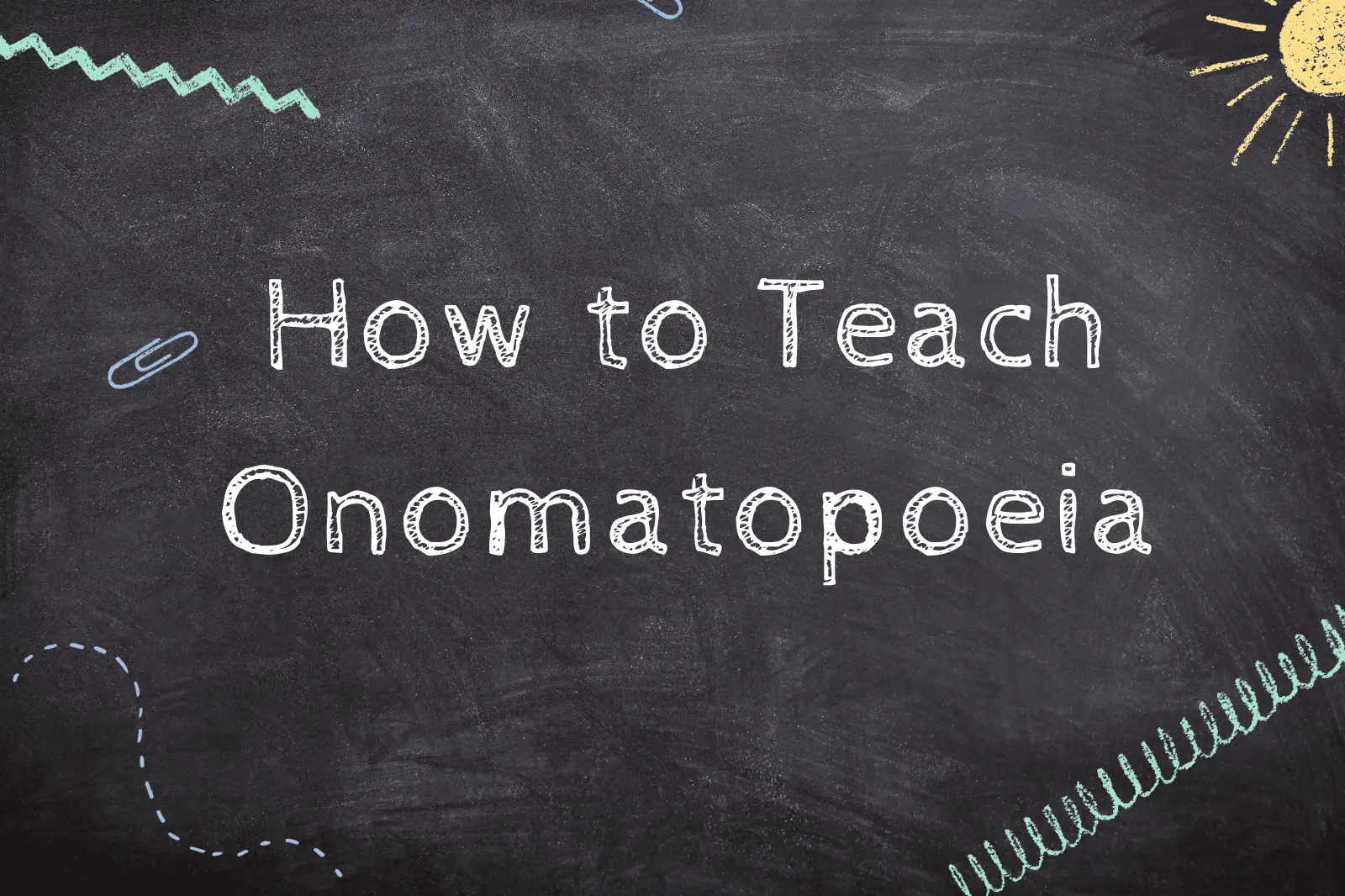
- Grammar Explained: ‘Who, What, When, Where, Why, How’

About The Author
I'm Dan Higgins, one of the faces behind The Teaching Couple. With 15 years in the education sector and a decade as a teacher, I've witnessed the highs and lows of school life. Over the years, my passion for supporting fellow teachers and making school more bearable has grown. The Teaching Couple is my platform to share strategies, tips, and insights from my journey. Together, we can shape a better school experience for all.

Join our email list to receive the latest updates.
Add your form here
Quotation Marks
We use quotation marks to show (or mark) the beginning and end of a word or phrase that is somehow special or comes from outside the text that we are writing. Quotation marks can be double ("...") or single ('...') - that is really a matter of style (but see below for more about this).
Quotation marks are also called "quotes" or "inverted commas".
1. Use quotation marks around the title or name of a book, film, ship etc:
- The third most popular book of all time, "Harry Potter", has sold over 400,000,000 copies.
- 'Titanic' is a 1997 movie directed by James Cameron about the sinking of the ship 'Titanic'.
Note that in the above case, we may use "italics" instead of quotation marks. So the above examples would then appear as:
- The third most popular book of all time, Harry Potter , has sold over 400,000,000 copies.
- Titanic is a 1997 movie directed by James Cameron about the sinking of the ship Titanic .
Obviously, the use of italics is not possible in handwriting or with old-style typewriters.
2. We use quotation marks around a piece of text that we are quoting or citing, usually from another source:
- In The Cambridge Encyclopedia of The English Language , David Crystal argues that punctuation "plays a critical role in the modern writing system".
3. Use quotation marks around dialogue or direct speech:
- It was a moonlit night. James opened the door and stepped onto the balcony, followed by Mary. They stood in silence for a few moments, looking at the moon. Then Mary turned to him and said: "Do you love me, James?"
4. Use quotation marks around a word or phrase that we see as slang or jargon:
- The police were called to a "disturbance" - which in reality was a pretty big fight.
5. Use quotation marks around a word or phrase that we want to make "special" in some way:
- Note that sometimes we use "italics" instead of quotation marks.
Double or single quotation marks?
Quotation marks can be double ("-") or single ('-'). If we want to use quotation marks inside quotation marks, then we use single inside double, or double inside single.
- He said to her: "I thought 'Titanic' was a good film."
- He said to her: 'I thought "Titanic" was a good film.'
Punctuation inside or outside final quotation mark?
If the quoted words end with a full stop, then the full stop goes inside the quotation marks. If the quoted words do not end with a full stop, then the full stop goes outside the quotation marks:
- He said: "I love you."
- She has read "War and Peace".
Note that in US English, the full stop usually goes inside the quotation marks in all cases:
- She has read "War and Peace."
However, US English adopts the British style for question marks and exclamation marks:
- He said: "Do you love me?"
- Have you read "War and Peace"?
- Can you imagine? He has never read "War and Peace"!
How do we indicate quotation marks when speaking?
People may say "quote, unquote" or "open quotes, close quotes" when reading aloud texts containing quotation marks:
- On page two it says, quote, Now is the time to invest, unquote.
- On page two it says, open quotes, Now is the time to invest, close quotes.
"Quote, unquote" may also be said informally in front of rather than around the quoted words:
- The brochure describes the car as, quote, unquote, total luxury.
"Quote, unquote" is sometimes used to mock or show disapproval or disbelief:
- Then he arrived with his quote, unquote new girlfriend.
People sometimes say "in quotes" (often putting up their two hands with two fingers extended on each hand, like quotation marks), indicating that the words came from another source, or in a mocking way, or suggesting that they don't quite believe what they have just said:
- Then he arrived with his new girlfriend, in quotes.
- Index of Punctuation Marks
- What is Punctuation?
- Punctuation Quizzes
- Punctuation Song
- Create new account
- Reset your password
Register and get FREE resources and activities
Ready to unlock all our resources?
What are speech marks?
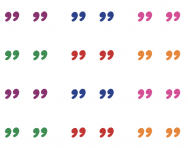
Inverted commas (also known as speech marks and quotation marks ) are punctuation marks that show us where direct speech starts and ends.
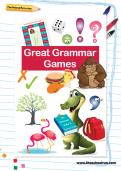
Download Fantastic FREE Grammar Resources!
- Perfect Punctuation Workbook
- Grammar Games Pack
- PLUS 100s of other grammar resources
Speech marks are not used if we are writing indirect (reported) speech.
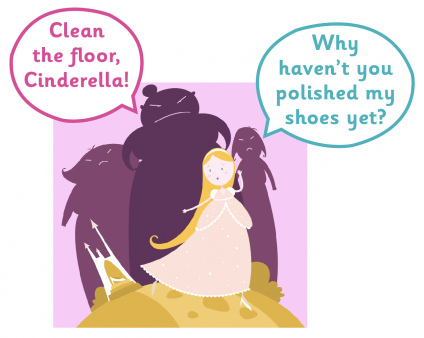
How are speech marks used?
Speech marks or inverted commas are used to show what the words actually spoken by a person or character are. Direct speech is separated from a reporting clause by a comma . For example:

As demonstrated in the example, the words spoken directly ( Although I wish they wouldn't my children fight all the time ) are marked by speech marks. The words spoken have also been separated by a reporting clause ( she sighed ).

When two or more people are having a conversation, a new line for each speaker is used , as this clarifies who is speaking. For example:

How are speech marks taught in the primary classroom?
When speech marks are first introduced in Year 3 , there is a lot of use of drama and reading class texts aloud. Children will identify direct speech within texts they are reading as a class.
In Year 4 there is more focus on multiple speakers.
In Years 5 and 6, children will be taught and expected to use the correct punctuation for speech, with multiple speakers and reporting clauses breaking up the direct speech.
When are speech marks taught in the primary-school classroom?
Inverted commas are first taught in Lower Key Stage 2, in Year 3. As punctuating direct speech is a fundamental primary-school writing objective , the use of speech marks will be reinforced in every subsequent year group.
In Year 3, teachers will focus more on simply punctuating the spoken words with inverted commas to indicate the specific words that have been spoken. In Year 4, this progresses onto using commas to separate the reported clause from the direct speech, and then using other forms of punctuation other than full stops within the inverted commas. For example:

In Years 3 and 4, children learn that the reporting clause can be positioned before or after the direct speech in the sentence.

During the SATs Spelling, Grammar and Punctuation test taken at the end of Year 6, children are also likely to be asked a question about inverted commas and/or the correct punctuation needed to show speech. For example:
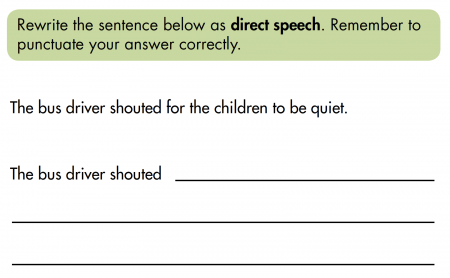
By the end of Year 6, when a child’s writing is assessed, they will be expected to use speech to move the action in their stories forward and to punctuate correctly.

Give your child a headstart
- FREE articles & expert information
- FREE resources & activities
- FREE homework help
More like this
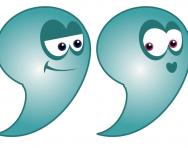
Purdue Online Writing Lab Purdue OWL® College of Liberal Arts
How to Use Quotation Marks

Welcome to the Purdue OWL
This page is brought to you by the OWL at Purdue University. When printing this page, you must include the entire legal notice.
Copyright ©1995-2018 by The Writing Lab & The OWL at Purdue and Purdue University. All rights reserved. This material may not be published, reproduced, broadcast, rewritten, or redistributed without permission. Use of this site constitutes acceptance of our terms and conditions of fair use.
A rundown of the general rules of when and where to use quotation marks.
Using Quotation Marks
The primary function of quotation marks is to set off and represent exact language (either spoken or written) that has come from somebody else. The quotation mark is also used to designate speech acts in fiction and sometimes poetry. Since you will most often use them when working with outside sources, successful use of quotation marks is a practical defense against accidental plagiarism and an excellent practice in academic honesty. The following rules of quotation mark use are the standard in the United States, although it may be of interest that usage rules for this punctuation do vary in other countries.
The following covers the basic use of quotation marks. For details and exceptions consult the separate sections of this guide.
Direct Quotations
Direct quotations involve incorporating another person's exact words into your own writing.
- Quotation marks always come in pairs. Do not open a quotation and fail to close it at the end of the quoted material.
Mr. Johnson, who was working in his field that morning, said, "The alien spaceship appeared right before my own two eyes."
Although Mr. Johnson has seen odd happenings on the farm, he stated that the spaceship "certainly takes the cake" when it comes to unexplainable activity.
"I didn't see an actual alien being," Mr. Johnson said, "but I sure wish I had."
When quoting text with a spelling or grammar error, you should transcribe the error exactly in your own text. However, also insert the term sic in italics directly after the mistake, and enclose it in brackets. Sic is from the Latin, and translates to "thus," "so," or "just as that." The word tells the reader that your quote is an exact reproduction of what you found, and the error is not your own.
Mr. Johnson says of the experience, "It's made me reconsider the existence of extraterestials [ sic ]."
- Quotations are most effective if you use them sparingly and keep them relatively short. Too many quotations in a research paper will get you accused of not producing original thought or material (they may also bore a reader who wants to know primarily what YOU have to say on the subject).
Indirect Quotations
Indirect quotations are not exact wordings but rather rephrasings or summaries of another person's words. In this case, it is not necessary to use quotation marks. However, indirect quotations still require proper citations, and you will be committing plagiarism if you fail to do so.
Many writers struggle with when to use direct quotations versus indirect quotations. Use the following tips to guide you in your choice.
Use direct quotations when the source material uses language that is particularly striking or notable. Do not rob such language of its power by altering it.
The above should never stand in for:
Use an indirect quotation (or paraphrase) when you merely need to summarize key incidents or details of the text.
Use direct quotations when the author you are quoting has coined a term unique to her or his research and relevant within your own paper.
When to use direct quotes versus indirect quotes is ultimately a choice you'll learn a feeling for with experience. However, always try to have a sense for why you've chosen your quote. In other words, never put quotes in your paper simply because your teacher says, "You must use quotes."
Looking to publish? Meet your dream editor, designer and marketer on Reedsy.
Find the perfect editor for your next book
1 million authors trust the professionals on Reedsy. Come meet them.
Last updated on Jul 24, 2023
6 Unbreakable Dialogue Punctuation Rules All Writers Must Know
Dialogue punctuation is a critical part of written speech that allows readers to understand when characters start and stop speaking. By following the proper punctuation rules — for example, that punctuation marks almost always fall within the quotation marks — a writer can ensure that their characters’ voices flow off the page with minimal distraction.
This post’ll show you how to format your dialogue to publishing standards.
6 essential dialogue punctuation rules:
1. Always put commas and periods inside the quote
2. use double quote marks for dialogue (if you’re in america), 3. start a new paragraph every time the speaker changes , 4. use dashes and ellipses to cut sentences off, 5. deploy single quote marks used for quotes within dialogue, 6. don’t use end quotes between paragraphs of speech .
The misplacement of periods and commas is the most common mistake writers make when punctuating dialogue. But it’s pretty simple, once you get the hang of it. You should always have the period inside the quote when completing a spoken sentence.
Example: “It’s time to pay the piper.”
As you’ll know, the most common way to indicate speech is to write dialogue in quotation marks and attribute it to a speaker with dialogue tags, such as he said , she said, or Margaret replied, or chirped Hiroko . This is what we call “attribution” when you're punctuating dialogue.
Insert a comma inside the quotation marks when the speaker is attributed after the dialogue.
Example: “Come closer so I can see you,” said the old man.
If the speaker is attributed before the dialogue, there is a comma outside the quotation marks.
Example: Aleela whimpered, “I don’t want to. I’m scared.”
If the utterance (to use a fancy linguistics term for dialogue 🤓) ends in a question mark or exclamation point, they would also be placed inside the quotation marks.

Exception: When it’s not direct dialogue.
You might see editors occasionally place a period outside the quotation marks. In those cases, the period is not used for spoken dialogue but for quoting sentence fragments, or perhaps when styling the title of a short story.
Mark’s favorite short story was “The Gift of the Magi”.
My father forced us to go camping, insisting that it would “build character”.

Now that we’ve covered the #1 rule of dialogue punctuation, let’s dig into some of the more nuanced points.
In American English, direct speech is normally represented with double quotation marks.
Example : “Hey, Billy! I’m driving to the drug store for a soda and Charleston Chew. Wanna come?” said Chad
In British and Commonwealth English, single quotation marks are the standard.
Example: ‘I say, old bean,’ the wicketkeeper said, ‘Thomas really hit us for six. Let’s pull up stumps and retire to the pavilion for tea.’
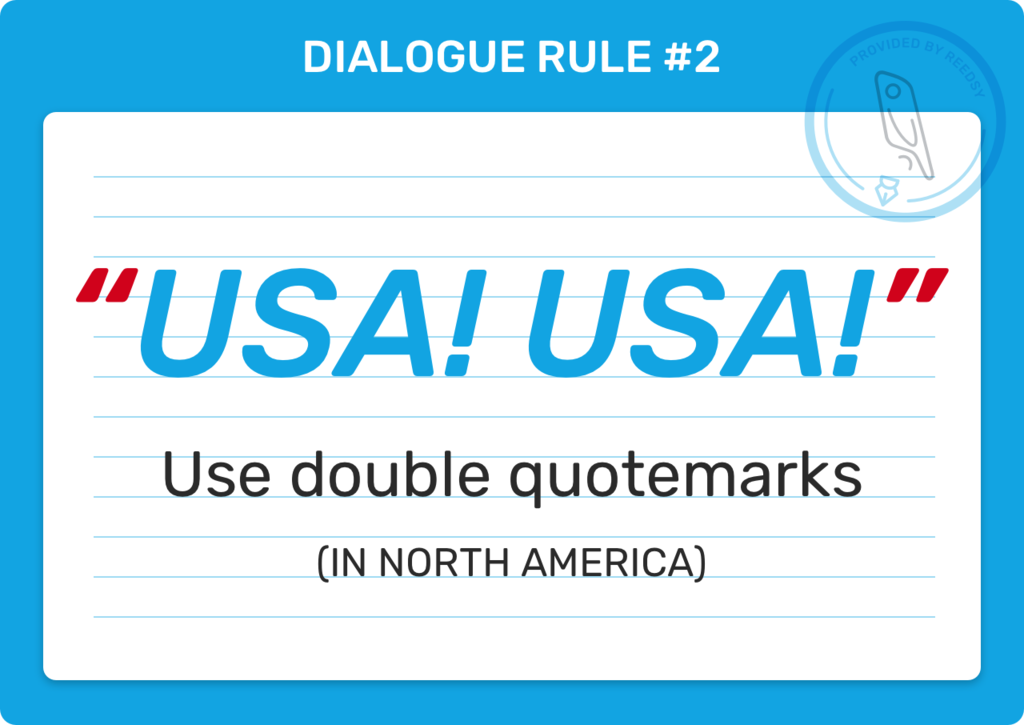
This is one of the most fundamental rules of organizing dialogue. To make it easier for readers to follow what’s happening, start a new paragraph every time the speaker changes, even if you use dialogue tags.
“What do you think you’re doing?” asked the policeman. “Oh, nothing, officer. Just looking for my hat,” I replied.
The new paragraph doesn’t always have to start with direct quotes. Whenever the focus moves from one speaker to the other, that’s when you start a new paragraph. Here’s an alternative to the example above:
“What do you think you’re doing?” asked the policeman. I scrambled for an answer. “Oh, nothing, officer. Just looking for my hat.”

FREE COURSE
How to Write Believable Dialogue
Master the art of dialogue in 10 five-minute lessons.
So far, all of the examples we’ve shown you are of characters speaking in full, complete sentences. But as we all know, people don’t always get to the end of their thoughts before their either trail off or are interrupted by others. Here’s how you can show that on the page.
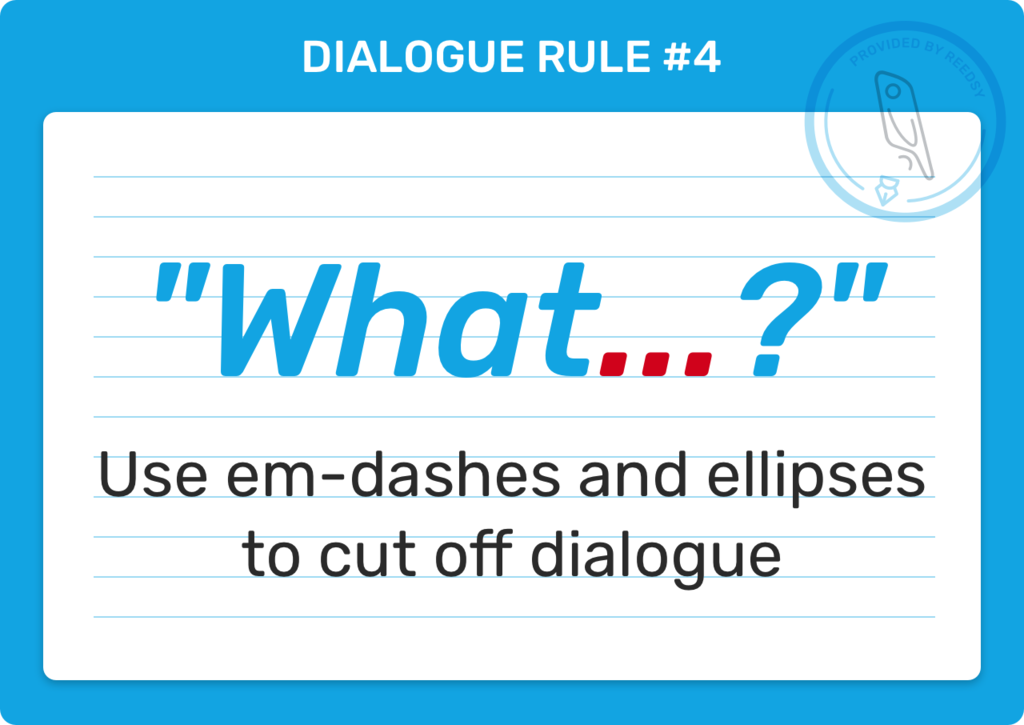
Em-dashes to interrupt
When a speaking character is cut off, either by another person or a sudden event, use an em-dash inside the quotation marks. These are the longest dashes and can be typed by hitting alt-shift-dash on your keyboard (or option-shift-dash for Mac users).
“Captain, we only have twenty seconds before—” A deafening explosion ripped through the ship’s hull. It was already too late.
“Ali, please tell me what’s going—” “There’s no use talking!” he barked.
You can also overlap dialogue to show one character speaking over another.
Mathieu put his feet up as the lecturer continued. "Current estimates indicate that a human mission will land on Mars within the next decade—" "Fat chance." "—with colonization efforts following soon thereafter."
Sometime people won’t finish their sentences, and it’s not because they’ve been interrupted. If this is the case, you’ll want to…
Trail off with ellipses
You can indicate the speaker trailing off with ellipses (. . .) inside the quotation marks.
Velasquez patted each of her pockets. “I swear I had my keys . . .”
Ellipses can also suggest a small pause between two people speaking.
Dawei was in shock. “I can’t believe it . . .” “Yeah, me neither,” Lan Lan whispered.
💡Pro tip: The Chicago Manual of Style requires a space between each period of the ellipses. Most word processors will automatically detect the dot-dot-dot and re-style them for you — but if you want to be exact, manually enter the spaces in between the three periods.
In the course of natural speech, people will often directly quote what other people have said. If this is the case, use single quotation marks within the doubles and follow the usual rules of punctuating dialogue.
“What did Randy say to you?” Beattie asked. “He told me, ‘I got a surprise for you,’ and then he life. Strange, huh?”
But what if a character is quoting another person, who is also quoting another person? In complex cases like this (which thankfully aren’t that common), you will alternate double quotation marks with single quotes.
“I asked Gennadi if he thinks I’m getting the promotion and he said, ‘The boss pulled me aside and asked, “Is Sergei going planning to stay on next year?”’”
The punctuation at the end is a double quote mark, followed by a single quote mark, followed by another double quote. It closes off:
- What the boss said,
- What Gennadi said, and
- What Sergei, the speaker, said.
Quoting quotes within quotes can get messy, so consider focusing on indirect speech. Simply relate the gist of what someone said:
“I pressed Gennadi on my promotion. He said the boss pulled him aside and asked him if I was leaving next year.”

In all the examples above, each character has said fewer than 10 or 20 words at a time. But if a character speaks more than a few sentences at a time, to deliver a speech for example, you can split their speech into multiple paragraphs. To do this:
- Start each subsequent paragraph with an opening quotation mark; and
- ONLY use a closing quotation mark on the final paragraph.
"Would you like to hear my plan?" the professor said, lighting his oak pipe with a match. "The first stage involves undermining the dean's credibility: a small student protesst here, a little harassment rumor there. It all starts to add up. "Stage two involves the board of trustees, with whom I've been ingratiating myself for the past two semesters."
Notice how the first paragraph doesn't end with an end quote? This indicates that the same person is speaking in the next paragraph. You can always break up any extended speech with action beats to avoid pages and pages of uninterrupted monologue.
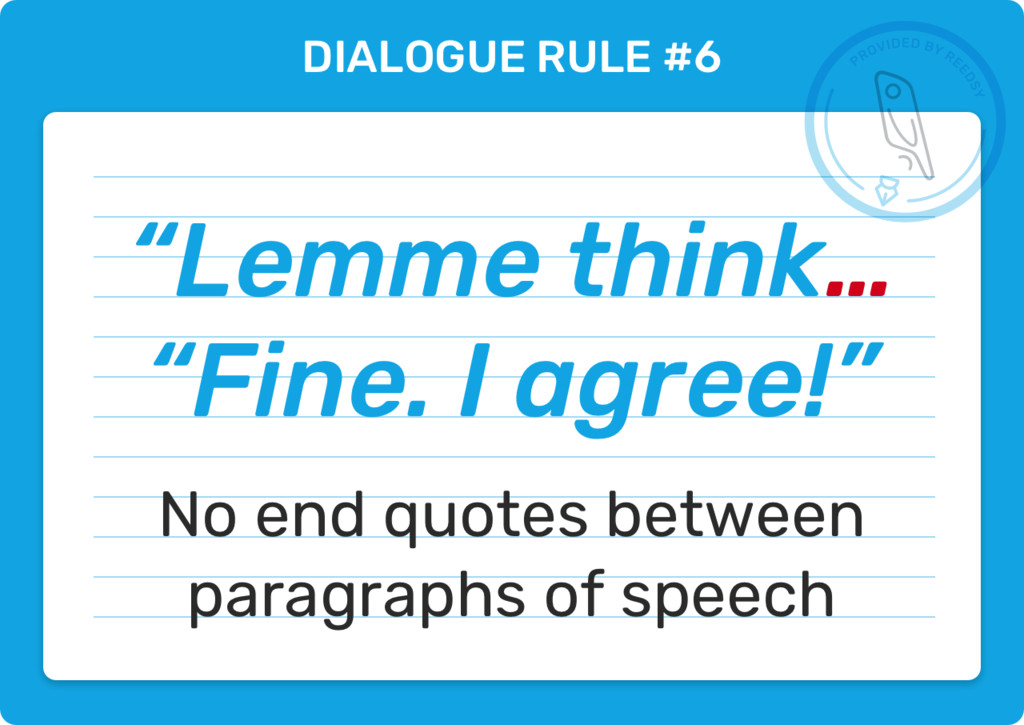
Want to see a great example of action beats breaking up a monologue? Check out this example from Sherlock Holmes.
Hopefully, these guidelines have clarified a few things about punctuating dialogue. In the next parts of this guide, you’ll see these rules in action as we dive into dialogue tags and look at some more dialogue examples here .
Join a community of over 1 million authors
Reedsy is more than just a blog. Become a member today to discover how we can help you publish a beautiful book.

We made a writing app for you
Yes, you! Write. Format. Export for ebook and print. 100% free, always.

1 million authors trust the professionals on Reedsy. Come meet them.
Enter your email or get started with a social account:
Our websites may use cookies to personalize and enhance your experience. By continuing without changing your cookie settings, you agree to this collection. For more information, please see our University Websites Privacy Notice .
College of Liberal Arts and Sciences
Department of Speech, Language, and Hearing Sciences

AuD Student
Speech, Language, and Hearing Sciences
Join our mailing list and receive your free eBook. You'll also receive great tips on story editing, our best blogs, and learn how to use Fictionary software to make your story unforgettable.
- Comments This field is for validation purposes and should be left unchanged.
Blogs / For Writers / 5 Tips For Writing Children Characters Well
5 Tips For Writing Children Characters Well
Stories we read as children can provide some of our very first friends. These children’s characters teach us those important early lessons of how to be brave, kind, strong and generous. For characters who become not only friends but teachers, they must be memorable and engaging.
Consider the following five tips for writing engaging children’s characters.
5 Tips For Writing Children Characters
Child characters should have a clear goal.
Children’s literature differs from adult literature in considerable ways; however, they are both meant to engage and entertain their reader.
So, it makes sense that some of the strong story telling techniques used for adults might also be important for creating children’s characters. One important crossover trait is having a clear goal for the main character of the story.
Children’s characters in storytelling, depending on the age category of the book, often represent an idea or stand for an ideal. Their motivations reflect those ideals. And much like the characters in adult literature, these children’s characters with clear goals will also go through a change.
Consider The Lorax , by Dr. Suess.
While The Lorax is one of many memorable children’s characters who states his goal with clarity, “I speak for the trees!”, The Once-ler, tells most of the story to the narrator and reveals his own change from the once greedy Once-ler to a character passing on a warning against his own mistakes and hope for the future.
Also consider The Ugly Duckling, by Hans Christian Anderson.
The Ugly Duckling has a clear goal of seeking acceptance from the first pages of the story. He leaves his home and finds rejection and heartache everywhere he hopes will be comfort. Only in his final moments, where he is sure this last place will be his end does he see his reflection and hear the voices of the children praising his beauty.
Child Characters Should Have Memorable Names
Character names (particularly children’s characters names) reveal much about a character when they are chosen with intention. A character name might be chosen based on sound, meaning, or description.
Consider some of the names J.K Rowling chooses to use in her Harry Potter Series .
A name like Snape is close in sound to the word snake , which is not an insignificant tie to the man who is head of Slytherin House. The likeness in the sound makes the reader associate this character with all the serpent metaphors in the novels, and question his intentions throughout the series.
Hermione, on the other hand, has a name from Greek origin, meaning messenger. As a character who is usually bringing in the knowledge needed by Harry and his friends, the name given to her seems appropriate in her character role.
Children’s characters named by a title that defines them are obvious in the stories of Winnie the Pooh by A.A. Milne .
Aside from Winnie the Pooh, the cast of characters such as Rabbit, Piglet, and Owl let the reader know not only what they are but how they will function in the story.
Rabbit spends much of his time focused on his garden and vegetables. Owl offers members of The Hundred Acre Wood wisdom.
Piglet is scattered and afraid.
Each children’s character (in this context) reveals the expectations readers have come to associate with these specific animals.
Find more advice for Naming Characters here https://fictionary.co/journal/an-editors-view-of-character-names/
Language Reveals Character Intentions
Language and word choice can reveal much about a character, including age, authority, and motivation. If we continue to look at Milne’s children’s characters, we see Pooh revealed in the following quote from Chapter One of The House at Pooh Corner :
“’He’s out,’” said Pooh sadly. ‘That’s what it is. He’s not in. I shall have to go a fast Thinking Walk by myself. Bother!’”
In this quote, Pooh repeats himself. He states the obvious and uses and endearing term for a walk. He gives a statement of innocent exasperation. Within the language, we get a sense of who Pooh is as a character.
Consider the language of Mr. Badger in The Wind in the Willows by Kenneth Grahame, when Rat begs to be let into his home.
“’Why, Ratty, my dear little man!’ exclaimed the Badger, in quite a different voice. ‘Well, I never! Lost in the snow!’”
The expressions my dear little man and well, I never reveal both the superiority Badger feels about himself, and the time-period of the story setting. These phrases might have been more common when Grahame first published his work in 1908.
How to Describe a Child in Writing
Much like names and language, description of physical traits, clothing, and mannerisms can reveal a lot about a children’s character.
Take for example, the mystery in Graeme Base’s, The Eleventh Hour .
Each guest is described in detail as the enter the feast. And while they are each in costume, the reader makes assumption about their natural animal instincts to steal the feast.
Graeme challenges his young readers with these expectations to solve the mystery.
In Little Red Riding Hood by The Brothers Grimm, the description the reader gets when Little Red Riding Hood thinks she is visiting her grandmother reveals the truth of the character and creates tension in the story. (Those big ears, big eyes, and big hands!)
Find more advice on connecting readers with character description here https://fictionary.co/journal/connect-readers-with-characters-using-description/
Writing Child Characters For Each Age Group
When writing engaging children’s characters, a writer should also be keenly aware of the age of their audience.
Age ranges in children’s literature
- Early readers – ages 4-8
- First chapter books and graphic novels – ages 6-9
- Middle-grade novels and graphic novels – ages 8-12
- Young adult novels and graphic novels – ages 12-18
The age range in children’s literature will be important when using the other tips in this article.
The goals, changes, language and descriptions of engaging characters for a 5 year old will most likely be very different for a reader closer to age 10. The writer should consider the age and stage of the reader if they want their story to connect.
Find information on editing characters here https://fictionary.co/journal/5-character-elements-of-a-story-explained/
How to Write Child Characters: Conclusion
First stories and first characters live forever with many readers, but they hold a particularly sacred place in the heart of a writer.
Those characters were also the first to inspire in the writer a passion to tell stories and write characters that will be memorable for the young readers picking up their first books today.
Now, go have a blast writing children’s characters!

IMAGES
VIDEO
COMMENTS
How to use speech marks when writing. If you'd like to quote a phrase or statement, using speech marks will show the reader that these aren't your original words. Speech marks are also a great way to give emphasis to certain phrases. If you're writing stories, they'll also help to separate when the different characters are talking.
Direct speech Direct speech gives the actual words that a speaker used. It is common in novels and other writing where the actual words of a speaker are quoted.
The quotation marks symbol is a type of punctuation used for setting words and passages apart from the rest of the text. Quotation marks, or "quotes" for short, look just like commas, except quotation marks are at the top of a line instead of at the bottom. Double quotation marks are simply two "commas" next to each other, while single ...
What quote marks are used for. Quote marks are used in 3 ways in fiction: Character dialogue. To distance the narrator from what's being reported. To denote song titles and other works. Character dialogue. Quote marks show that we're reporting what someone else is saying or said.
Revised on November 29, 2022 by Jack Caulfield. Quotation marks (also known as quotes or inverted commas) are used to indicate direct speech and quotations. In academic writing, you need to use quotation marks when you quote a source. This includes quotes from published works and primary data such as interviews.
Single quotation marks are also known as 'quote marks', 'quotes', 'speech marks' or 'inverted commas'. Use them to: show direct speech and the quoted work of other writers. enclose the title of certain works. draw attention to a word you're defining. Double quotation marks aren't Australian Government style. Use them only ...
The Role and Importance of Speech Marks in Writing and Reading. Speech marks serve a critical function in both writing and reading. In writing, they help to distinguish dialogue from narrative, highlight specific phrases or words for emphasis, and indicate direct quotations from sources.
Learn how to use speech marks (and other punctuation) to punctuate direct speech.Find more speech marks resources at https://easyteaching.net/literacy-resour...
Speech Marks (also known as inverted commas) are a type of speech punctuation used to show when someone is speaking in a piece of writing (direct speech). They help to differentiate between text that has been/is being spoken and text that is not. Download FREE teacher-made resources covering 'Speech Marks'. View FREE Resources.
An explanation on how to use speech marks correctly - learn these rules to avoid mistakes in your writing.For more beneficial content, please show your suppo...
Rule 4. Periods and commas ALWAYS go inside quotation marks. Examples: The sign read, "Walk.". Then it said, "Don't Walk," then, "Walk," all within thirty seconds. He yelled, "Hurry up.". Rule 5a. The placement of question marks with quotation marks follows logic. If a question is within the quoted material, a question mark ...
2. We use quotation marks around a piece of text that we are quoting or citing, usually from another source: In The Cambridge Encyclopedia of The English Language, David Crystal argues that punctuation "plays a critical role in the modern writing system". 3. Use quotation marks around dialogue or direct speech: It was a moonlit night.
Grammarly. Updated on May 10, 2023 Grammar. Quotation marks are used to identify words that someone has said. You'll often find them in fiction, where they signify dialogue, the words spoken by the characters. In newspapers, journalists use quotation marks to signify that something is a direct quote from a person in the article.
In the realm of punctuation, speech marks, also known as quotation marks or inverted commas, are symbols used to enclose direct speech or a quotation within a written text. They serve as a visual indicator, guiding readers to identify the exact words spoken by someone or taken from another source. Speech marks are represented by a pair of ...
The most common use of speech marks is to punctuate direct speech. Direct speech is any speech spoken directly by a person or character. For example: "I'm tired!" Lauren complained. Direct speech can be the most complicated type of speech to punctuate because of the placement of the speech marks and punctuation in each sentence. The main rules ...
Inverted commas are first taught in Lower Key Stage 2, in Year 3. As punctuating direct speech is a fundamental primary-school writing objective, the use of speech marks will be reinforced in every subsequent year group.. In Year 3, teachers will focus more on simply punctuating the spoken words with inverted commas to indicate the specific words that have been spoken.
Using Quotation Marks. The primary function of quotation marks is to set off and represent exact language (either spoken or written) that has come from somebody else. The quotation mark is also used to designate speech acts in fiction and sometimes poetry. Since you will most often use them when working with outside sources, successful use of ...
4. Use dashes and ellipses to cut sentences off. 5. Deploy single quote marks used for quotes within dialogue. 6. Don't use end quotes between paragraphs of speech. 1. Always put commas and periods inside the quote. The misplacement of periods and commas is the most common mistake writers make when punctuating dialogue.
Speech Marks (also known as inverted commas) are a type of speech punctuation used to show when someone is speaking in a piece of writing (direct speech). They help to differentiate between text that has been/is being spoken and text that is not. Download FREE teacher-made resources covering 'Speech Marks'. View FREE Resources.
Punctuating direct speech. A new speaker needs a new line. You should use a capital letter at the start of each piece of speech. Punctuation (question marks, full stops and exclamation marks) go ...
A clear and concise explanation of how to correctly use speech marks, breaking down the need for capital letters and punctuation marks. What will I learn? ...
A punctuation mark is then used after the reporting clause, before the next set of speech marks. If you've put the reporting clause in the middle of a sentence of speech then this should be a ...
Step 3: Edit and polish what you've written until you have a cohesive first draft of your speech. Step 4: Practice, practice, practice. The more you practice your speech the more you'll discover which sections need reworked, which transitions should be improved, and which sentences are hard to say. You'll also find out how you're doing ...
Admissions. Master of Arts in Speech, Language, and Hearing Sciences (MA) Doctorate of Audiology (Au.D.) Doctorate of Philosophy in Speech, Language, and Hearing Sciences (Ph.D.) Courses.
Writing Child Characters For Each Age Group. When writing engaging children's characters, a writer should also be keenly aware of the age of their audience. The age range in children's literature will be important when using the other tips in this article. The goals, changes, language and descriptions of engaging characters for a 5 year old ...